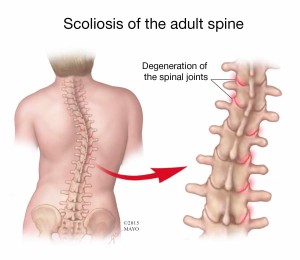-
Mayo Clinic Q and A: For adults with scoliosis, treatment based on severity of symptoms
 DEAR MAYO CLINIC: How effective is surgery to treat scoliosis in adults? What does the surgery involve?
DEAR MAYO CLINIC: How effective is surgery to treat scoliosis in adults? What does the surgery involve?
ANSWER: Fortunately for most adults who have scoliosis, the condition can be successfully managed without surgery. For some who suffer from an overly tilted or arthritic spine, though, surgery can be very effective at relieving symptoms. The surgery is a complex procedure and can include removing some spinal joints and connecting two or more of the bones in the spine together to properly balance the spine and improve quality of life.
Scoliosis is a three-dimensional change in the normal shape of the spine that leads to excessive sideways or forward curves. It most often develops in children during the growth spurt just before puberty. But some adults can suffer from scoliosis, too.
For adults affected by scoliosis, the curve may be a remnant of scoliosis that developed during childhood. More commonly, though, adult scoliosis happens as a result of the spinal wear and tear that comes with aging, usually in combination with another condition that affects the spine, such as arthritis or osteoporosis. In fact, it is usually arthritis or osteoporosis symptoms that cause the discomfort and disability that lead people to seek medical care.
When an adult is diagnosed with scoliosis, treatment is based on the severity of symptoms. If scoliosis is not causing any symptoms, treatment is not necessary. When symptoms become bothersome or limiting, then treatment is recommended. Symptoms may include low back pain, pain and numbness that radiates down one leg, leg weakness or a stooped posture.
Typically the first step in treatment involves physical therapy, along with stretching and making any necessary changes to diet and nutrition. Weight-bearing exercise such as walking can help maintain bone mass and ease scoliosis symptoms. If another medical condition such as osteoporosis is contributing to scoliosis, then treatment for that disorder is also necessary to help keep the spine curve from getting worse as the bones get softer. If pain lasts despite treatment, or if scoliosis symptoms are so severe that they limit mobility, then surgery may be appropriate.
It is not necessary to completely correct the abnormal spine curves to achieve a good surgical outcome. Adults with surgically treated scoliosis that end up with a balanced spine — that is, the head is positioned directly over the pelvis from front-to-back and side-to-side — can achieve a high degree of satisfaction after surgery.
A surgical procedure called spinal fusion is used to treat scoliosis. In many cases, joints in the spine are a significant part of the deformity. During surgery, those joints are removed. The surgeon may choose to replace them with filler made of bone or a bone-like material. Then, metal rods, hooks, screws or wire are inserted to hold in place the portion of the spine where the joints were replaced. This “loosens up” the spine and assists the surgeon to straighten, balance, and stabilize the spine.
The surgery may involve making incisions on the back or abdomen and waist to allow the surgeon access to the spine from many directions. The surgery can be quite prolonged and often takes six hours or more to complete. The length of hospital stay required after surgery typically is three to five days.
At some surgical centers, treatment for scoliosis can be accomplished via minimally invasive techniques that shorten recovery times. Regardless of the way it is treated, it can take several months after surgery for the spinal bones to heal and fuse together. During that time, a brace may be required to protect the spine.
After surgery, spinal mobility in the area where the bones were fused together is limited. Physical therapy can be helpful to teach people who have had spinal fusion ways to sit, stand, move and walk as part of improving their mobility and quality of life. Although spinal fusion surgery for adults with scoliosis may not eliminate all symptoms, in a high percentage of cases it can effectively balance the spine, relieve scoliosis symptoms, and improve overall quality of life. — Paul Huddleston, M.D., Orthopedic Surgery, Mayo Clinic, Rochester, Minn.
Related Articles







